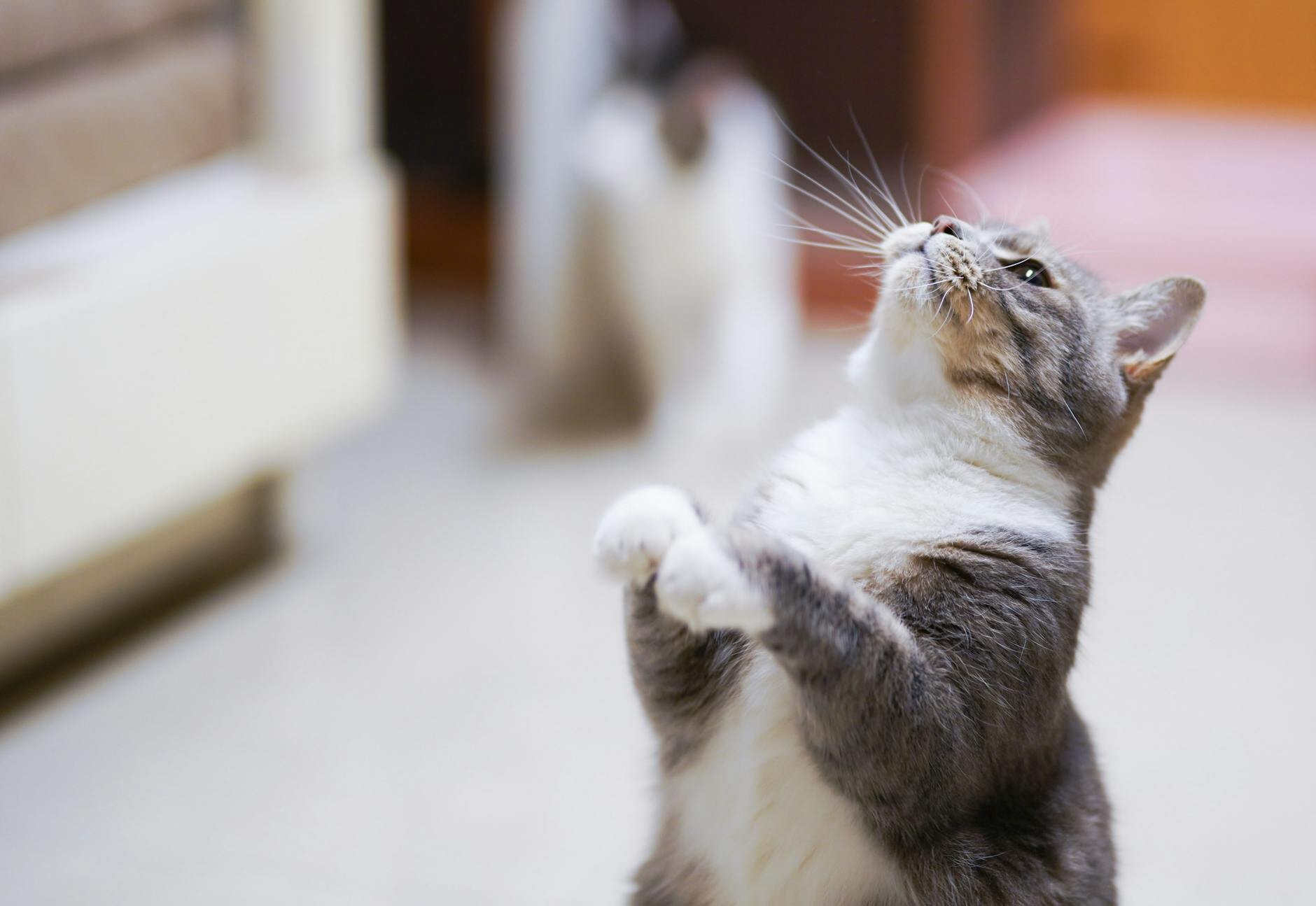Last Updated: 04/11/2025
Kitten Training Guide
"Have you just bought a kitten and wondering how to train it? Check out tips on feeding scratching toileting and how to stop biting from our vet team."
Author: Dr Belinda Stancombe BVSc (Hons)
Reading Time: 7 minutes - short read
Bringing a new kitten home is exciting, but as a new owner it can sometimes seem overwhelming. We all want what is best for our new pet, but just knowing where to start can be a challenge. We want everything to go smoothly, and our kitten to grow up without the problem behaviours which can often be associated with cat ownership.
This article is your guide on how to establish good kitten behaviours that will last a lifetime.
Better kitten bundle
Need supplies for a new kitten? Check out our Better Kitten Bundle - a complete vet-approved kitten essentials pack, designed to help tick off your 'new kitten checklist'. It contains parasite prevention, toys, a scratcher, treats, litter, food vouchers, and more!
Filled with over $185 worth of products, our discounted price ($49.95) makes for incredible value. You couldn't ask for a more 'purrfect' welcome pack for a new kitten!
How do I toilet train my kitten?

Cats are naturally very clean animals, so toilet training is generally quite easy with new kittens. You will need to invest in a good quality litter tray, ideally with low sides that are easy to access for little kitten legs.
If you know what litter the kitten has used prior to adoption, it is recommended to use the same litter initially. This will make toilet training a lot easier to begin with. Not all litter types are considered safe for kittens. When choosing a litter for kittens it is recommmended to opt for paper or natural based litters such as wood, tofu or corn, and avoid clay or crystal litters as these can be harmful if ingested.
When you first bring your kitten home, keep them isolated to one room initially. This will give them time to adjust to the change in environment and learn to use the litter tray. Place a feliway diffuser in the room to help them feel calm in their new surroundings.
Place them in the litter tray and, gently using their paw, encourage them to scratch around. This will give them an idea of what do in the litter box. You can place them in the tray several times a day, after playing, eating or sleeping, to encourage them to use it at times that they typically need to toilet. Once they have perfected the litter tray in this room, then allow access to the rest of the house.
Place the litter tray in a central location where the kitten spends a lot of time, so that they have easy access to the tray. You should have multiple trays for the different areas of the house, especially important in multi-story houses, as this will minimise the likelihood of accidents happening. As your kitten grows, less litter trays will be required.
It is important to remember that kittens are still learning and accidents may still occur. In the event of an accident, do not reprimand your kitten. Clean the area up quickly using an enzyme-based cleaner, to ensure that the area is thoroughly cleaned and there is no residual smell. This will decrease the likelihood of your kitten urinating in the same area again.
As previously mentioned, cats are extremely clean animals. For this reason, it is important to clean and change the litter tray regularly. If the litter tray is not clean, then your kitten will be less likely to want to use it, and will be more likely to have accidents in other areas of the house.
Tips for success:
- Purchase several low sided litter trays
- Use the same litter (if possible) to help your kitten adjust
- Introduce your kitten to one room first to help them adjust to their new house
- Use a Feliway diffuser to help them feel calm in their new surrounding
- Place your kitten in the litter tray often, until they get the idea
- Have several litter trays in easy to reach locations
- Expect accidents as kittens are still learning
- Clean up accidents quickly using an enzyme based cleaner
- Clean the litter tray regularly
How do I stop my kitten from biting me?
Kittens love to play, and biting and scratching is part of normal kitten development. If you watch a litter of kittens play together, they will continually bite and scratch each other as part of the game. When a kitten bites the other too hard, the kitten on the receiving end will cry and let the other know "ow, that was too hard". This is how kittens learn bite inhibition or how hard to the bite each other, without hurting.
It is important that you continue to teach your kitten what is unacceptable play behaviour. If your kitten bites or scratches you too hard, say "ouch" with a firm voice and then redirect your kitten to an appropriate toy. This will teach your kitten that if they want to bite and scratch, then a toy is to correct place to do this. If your kitten continues to bite, you may want to consider placing them in 'time out'. This involves gently placing them in a quiet room so that they can calm down. Once they are calm and no longer over stimulated, then they can come out and continue playing correctly.
It is important to provide lots of toys and mental stimulation. Play is an important part of kitten development and a great bonding experience for you and your kitten. You should never use fingers or hands as a play toy. This may be cute as kittens, but soon they will grow up, and being bitten by a cat is a lot more painful! Most cats and kittens, do not like being touched on the tummy and this will often cause a biting response. When patting your kitten, avoid this area to ensure that patting is a positive and relationship building experience.
Sometimes biting can be a fear response. If your kitten has not been well socialised or handled prior to adoption, then they may be fearful of their new surroundings. With fearful kittens it is important to slowly introduce them to being handled. Try patting them slowly, several times a day to get them used to human contact and always make this a positive experience.
Lastly, if your kitten is biting when handled and has not shown this type of behaviour before, then this may be an indication that your kitten is in pain. In this case, an appointment with your veterinarian is recommended.
How do I stop my kitten from scratching the furniture?

Scratching is natural behaviour for kittens and cats. Cats scratch for many reasons. They use scratching to mark their territory both visually and through scent, from the glands in their paws. Scratching also helps to shed the outer layer or their claws and keeps them nice and sharp. While this is normal behaviour in our feline friends, it is very undesirable for us if the area that they choose to scratch is our favourite couch or carpet!
Here are some tips to help your kitten establish good scratching habits:
- Provide plenty of scratching posts
- Try different types and textures of scratch posts as they will often have a preference. Initially try one of each - carpet, rope, cardboard to see which one your kitten prefers
- Try vertical and horizontal scratch posts
If your kitten is already scratching some undesirable locations then apply some no scratch spray to discourage scratching. Double sided tape or sticky paws applied to high scratch areas can also prevent scratching, as cats and kittens do not like the feel.
Keeping your kitten's claws clipped short can help minimise the damage done from normal scratching behaviour. A good quality pair of Nail Clippers is essential for this task.
If scratching is an ongoing issue, then a visit to the veterinarian is recommended. Sometimes scratching can be a sign of anxiety and your veterinarian can recommend some strategies to help you manage these symptoms. Declawing cats and kittens robs them of their natural instincts to scratch and is banned in Australia.
What should I feed my kitten?
When selecting a diet for your kitten, it is important to select a food that is specifically formulated for their current life stage. Kitten diets have optimal levels of nutrients such as protein, fats, vitamins and minerals, to support growth and development.
It is important to choose a diet that is complete and balanced. Premium brand diets such as Hills Science diet, Royal canin and Advance are superior in quality to supermarket brands, with optimal nutrients and research into the quality of the product and brand.
If your kitten has not been started on solid food, introducing them to a wet food diet that is easy to eat such as Royal canin mother and baby. Once they have transitioned onto a wet food diet then you can slowly introduce them to a dry food diet. Milk is not required for kittens once they are weaned onto solid food.
There are pros and cons to feeding wet and dry food diets. Feeding both in combination will help to balance these out.
Advantages of dry food
- More convenient
- Cost effective
- Improved dental health
Advantages of wet food
- Better hydration
- Highly palatable
Veterinarians often recommend dry food diets to help promote good dental health. It is important that if you choose a wet food diet only, that you are providing adequate dental preventatives. This will become especially important as your kitten grows adult teeth at 3-5 months of age.
Replace this title and swap out the product cards below!
Can I teach my kitten tricks?

The answer is yes!! While tricks and training are something we commonly think of with puppies, kittens can also learn to sit, turn aroundâ¦the list is endless. You will need some high reward treats and a lot of patience!! Teach your cat to sit is a great article to get started.
It may take some practice, but it will be a great bonding experience for you and your kitten.
Articles recommended for you
Our vet authored guide to the benefits of feeding your dog fresh food plus tips and advice for introducing it into their regular menu.
See our guide to protecting your pet from parasites from our vet team.
Thinking of getting a fish? Check out our guide for setting up a tank and home care tips!
Looking to understand horse feeds better? This comprehensive guide covers feeding recommendations for horses of all ages and disciplines.
Does your pet suffer from anxiety? Check out our Vet-guide for treatment options to help your pet.
History
Our experts continually monitor the health and wellness space and we update our articles when new information becomes available.
Tue Nov 4 2025
Edited by Dr Belinda Stancombe BVSc (Hons)Dr Belinda Stancombe BVSc (Hons)
Veterinarian
Dr Belinda graduated from The University of Queensland in 2009 and has worked as a Small Animal Veterinarian for over 10 years in South East Queensland. She also has experience as a telehealh consultant, providing veterinary advice for online customers.She has a special interest in animal behaviour, preventative health, the human-animal bond and internal medicine. Outside of work hours she is closely affiliated with a kitten rescue and is also a devoted carer of orphaned rescue kittens.

